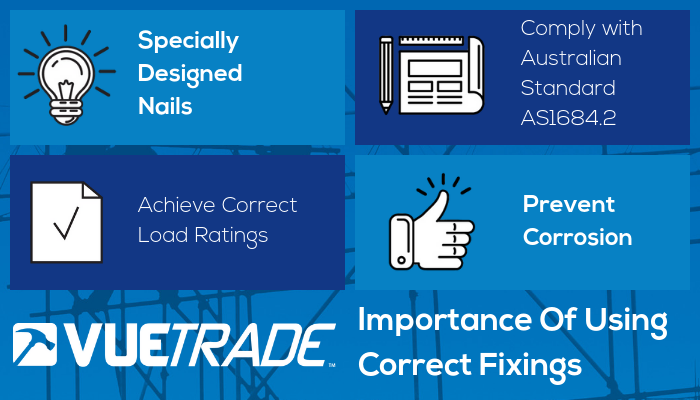
Always ensure you’re using the correct fixings for the bracket or building material you’re using. Using the wrong size or material fixing can result in poor load ratings, and/or corrosion of fixings or brackets. The outcome of using an incorrect fastener for the application can range from the cost of repairs and replacing corroded brackets, to the failure of a structure.
When fixings are required, all VUETRADE timber connectors e.g. brace strapping, triple grip should be fixed using our 30mm x 2.8mm Ø Connector Plate Nails. There are several reasons for this:
- VUETRADE Connector Plate Nails are specifically designed to suit all VUETRADE connector products e.g. brackets and brace strapping fixing. Special care should be given between the connector plate nail and clout as they look similar but are in fact two different products. VUETRADE connector product are manufactured as a whole from a single piece of steel whereas clouts are often manufactured separately then joined. This gives VUETRADE connector plate nail better holding strength compared to the clout. See our previous posts for more information on our Connector Plate Nails:
- Important Notice: VUETRADE Connector Plate Nails
- Case Study: Connector Plate Nails & Clouts
- VUETRADE products load ratings are calculated & tested with the specified fixings and can only be guaranteed if the specified fixings are used.
- In wall bracing applications the applicable Australian Standard AS1684.2 specifically notes that 30mm x 2.8mm nails should be used to fix strapping. You can refer to page 143 and page 144 of the AS1684.2 on Clause 8.3.6 Table 8.18 (b) and table 8.18(d).
- Stainless Steel Brackets should always be fixed using Stainless Steel nails to eliminate galvanic corrosion. As stainless steel and zinc coated carbon steel are dissimilar metal, the potential difference in these metals may induce accelerated corrosion attack on more cathodic metal (zinc) and compromise the connection strength. Refer to this discussion piece which explains how corrosion attack can occur on different metals.
- Case Study: Material Corrosion
